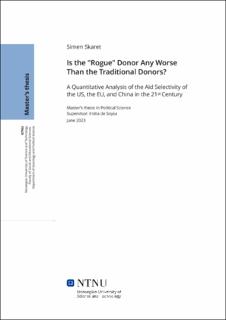| dc.contributor.advisor | de Soysa, Indra | |
| dc.contributor.author | Skaret, Simen | |
| dc.date.accessioned | 2023-07-13T17:21:06Z | |
| dc.date.available | 2023-07-13T17:21:06Z | |
| dc.date.issued | 2023 | |
| dc.identifier | no.ntnu:inspera:138964492:98057221 | |
| dc.identifier.uri | https://hdl.handle.net/11250/3078749 | |
| dc.description.abstract | Bistandsmidler som blir tildelt korrupte og undertrykkende myndigheter forventes å være mindre effektive for å oppnå utviklingsmål og kan til og med forlenge styret til selvtjenende autokrater som hindrer utvikling. På grunn av dette har bistandsselektivitet, som refererer til bistandsgiveres valg om hvordan de allokerer bistand, blitt en viktig del av bistandsdebatten. Den dominerende forestillingen av kinesisk bistandsselektivitet i Vesten er at det er en «rogue» bistandsgiver. Samtidig er utenrikspolitikken til vestlige bistandsgivere ofte beskyldt for hykleri. Denne oppgaven undersøker bistandsselektiviteten til USA, EU, og Kina i det 21. århundre, tre av de største bilaterale bistandsgiverne i nylige år, ved å bruke kvantitative modeller med tverrsnittsdata med tidsserie (TSCS). Bistandsselektivitet er målt som bistandsgivernes evne til å allokere mindre bistand til mer korrupte og undertrykkende regjeringer. Resultatene støtter ikke den negative forestillingen av Kina som bistandsgiver. Istedenfor antyder de at forskjellene mellom Kina og de tradisjonelle Vestlige bistandsgiverne, USA og EU, er minimale. I en separat modell som kun undersøker bistandsallokering til Afrika sør for Sahara viser Kina seg å være mer responsiv til nivåer av korrupsjon og undertrykkelse enn sine Vestlige motstykker. | |
| dc.description.abstract | Foreign aid funds allocated to corrupt and repressive governments are expected to be less effective at achieving development objectives and may even prolong the incumbency of self-serving autocrats who impede development. For this reason, aid selectivity, referring to the donor’s decision of how to allocate its aid, has become an important part of the aid discourse. The dominant narrative of Chinese aid selectivity in the West is that of a “rogue” donor. Meanwhile, the foreign policy of Western donors is often accused of hypocrisy. This thesis will investigate the aid selectivity of the US, the EU, and China in the 21st century, three of the largest bilateral donors in recent years, using quantitative models with time-series cross-sectional (TSCS) data. Aid selectivity is measured by their ability to allocate less aid to more corrupt and repressive governments. The results do not support the narrative of China as a rogue donor. Rather, it suggests that the differences between China and the traditional Western donors of the US and the EU are minimal. In a separate model investigating aid allocations to sub-Saharan Africa only, China is even found to be more responsive to levels of corruption and repression than its Western counterparts. | |
| dc.language | eng | |
| dc.publisher | NTNU | |
| dc.title | Is the "Rogue" Donor Any Worse Than the Traditional Donors? A Quantitative Analysis of the Aid Selectivity of the US, the EU, and China in the 21st Century | |
| dc.type | Master thesis | |
